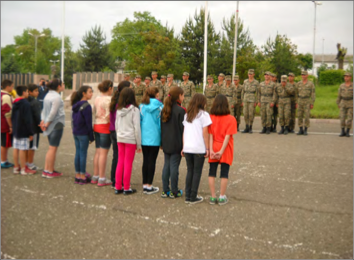Discovering Hayastan Through the Eyes of Children
Jul/08/2013 Archived in:Armenia

The author of this article, Muriel Mirak-Weissbach, with her niece, Christina Kew, in Armenia
Special to the Mirror-Spectator
WATERTOWN and YEREVAN — For too long the term “diaspora” designated both the identity and homeland for many Armenians. The post-World War I republic was short-lived and Soviet Armenia, especially during the Cold War, was a remote reality, both geographically and politically. Since 1991, that has happily changed, and Armenians worldwide can look at the Republic of Armenia as their “other half.” Armenian Ambassador to Germany Armen Martirosyan has said of these two pillars, “Our unity is the source of our strength and our diversity is the source of our resilience.”
For the diaspora, a visit to Armenia is more than a vacation or a cultural discovery; it is a journey through one’s own past which lends a new dimension to one’s identity. I had the honor of chaperoning my great niece for the first half of her two-week visit there. Christina, the 11-year-old daughter of my niece Julia Mirak Kew, is a fifth-grade student at St. Stephen’s Armenian Elementary School in Watertown. I flew to Yerevan from my home in Germany and a week later, Julia arrived from Boston. Every year the school’s graduating class makes the long trip, this year being the 10th anniversary. Although I had visited the country before, this time I was able to live the joy of discovery through the eyes of the children, and to appreciate a special kind of interaction between them and the people who welcomed them.
Although there was a culture shock, as the Bostonians were not accustomed to strolling down the streets of a major capital city at 10 p.m. among hundreds of local citizens, mostly young couples with children, or to hear music piped through loudspeakers in Republic Square as the water fountains danced in changing colors, still, the language they spoke was just as familiar as the lamejun and kebab served in the restaurants. Despite the differences between Eastern and Western Armenian, the children (and their parents) could communicate with ease. When visiting schools in Yerevan or Shushi (in Nagorno Karabagh), the girls and boys from St. Stephen’s chatted with their counterparts; they all knew the same poems and songs, which both groups would perform. And if there was a soccer field nearby, they would quickly line up in teams and kick the ball. (St. Stephen’s won both games.)
The fact that all the children spoke fluent Armenian, even in conversation with one another, had a powerful impact on the local residents. In Echmiadzin on the first day as well as in Sardarabad, during Independence Day celebrations, TV channels rushed to interview them. And they cherish their language; they took special delight in the life-size stone letters of the alphabet invented by Mesrop, which theydiscovered in Oshagan, the great scholar’s final resting place.
The few days in Artsakh (or Karabagh) were very special. Although the bus ride from Yerevan was a long nine hours, it was broken up with stops at historic sites, where we could marvel at several of the innumerable treasures of Armenian church architecture: from the monastery of Khor Virab, where Gregory the Illuminator was imprisoned (and into whose dark dank dungeon the children descended), to the 13th-century masterpiece of Noravank, with its perilously steep stone steps up the front façade (which the children did not hesitate to ascend).
In Karabagh, we encountered monuments to a much more recent past. If the tank used in the 1992 battle of Shushi was fun for the children to climb up on; it was a no toy, but a dramatic reminder of the life-and-death struggle to liberate the city. “I felt so proud that I stood on the tank that freed Shushi,” wrote Sarine in her report. At the Shushi museum, the children received a detailed lecture on the battle, illustrated with the help of a model, and wandered
through the rooms of another museum dedicated to the memory of those young men and women who gave their lives in the war. Their black-and-white photos cover the high walls of the rooms, and the birth and death dates testify to the tender age at which they perished. An unscheduled visit to the military base in Stepanakert provided a glimpse into the harsh conditions under which soldiers today serve to defend the republic. After completing their marching drill, a group of soldiers stood at attention to listen to the St. Stephen’s students sing patriotic songs, then broke into enthusiastic applause before posing for pictures.
Such scenes were moving, as they captured a moment of mutual recognition: of the Armenians there, who have waged the struggle for liberation, and the very young Armenians here, who, in learning about it and the thousands of years of prior history, can reflect on who they are. “We saw our ancestors’ homeland,” wrote Gregory in his report.

Students meet young Artsakh soldiers at a barracks in Stepanakert.

